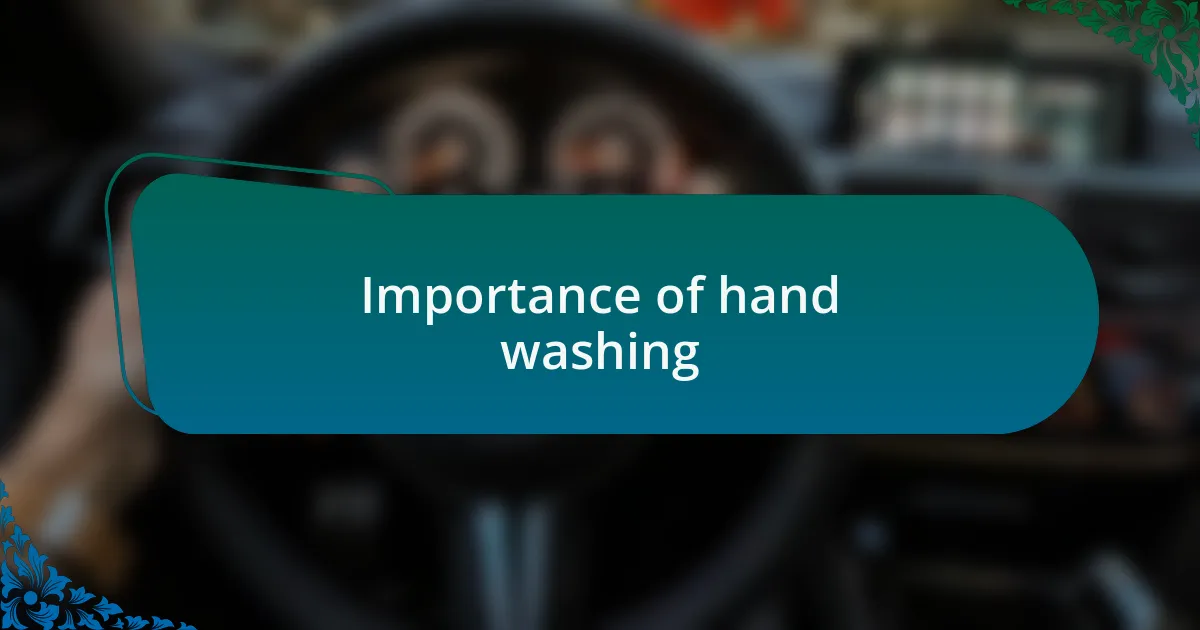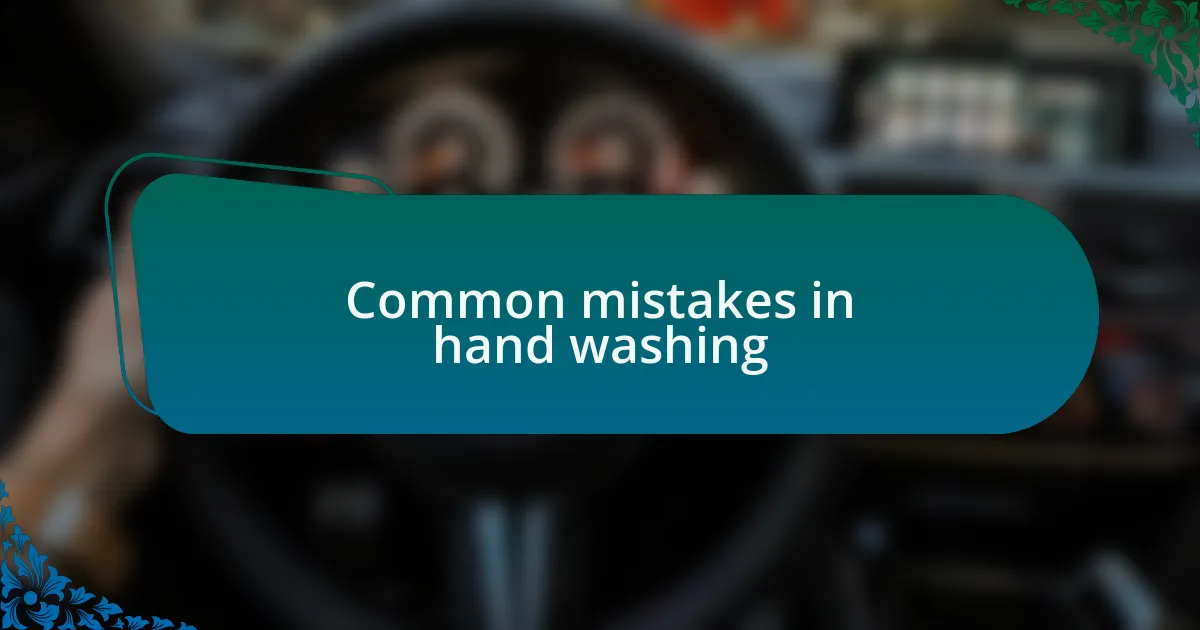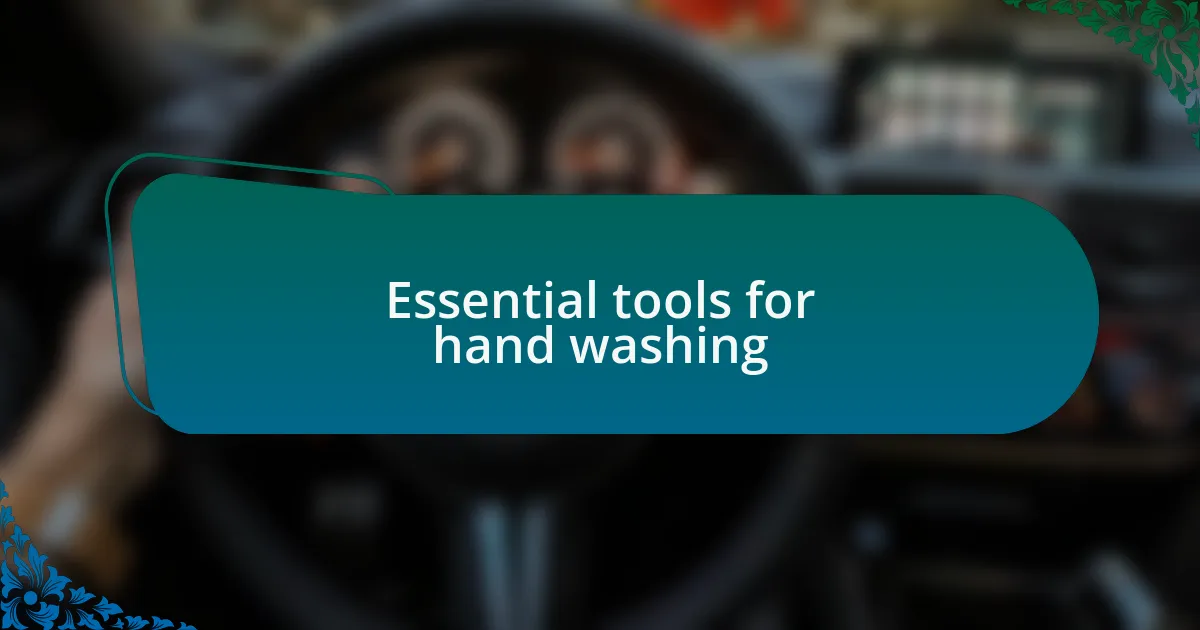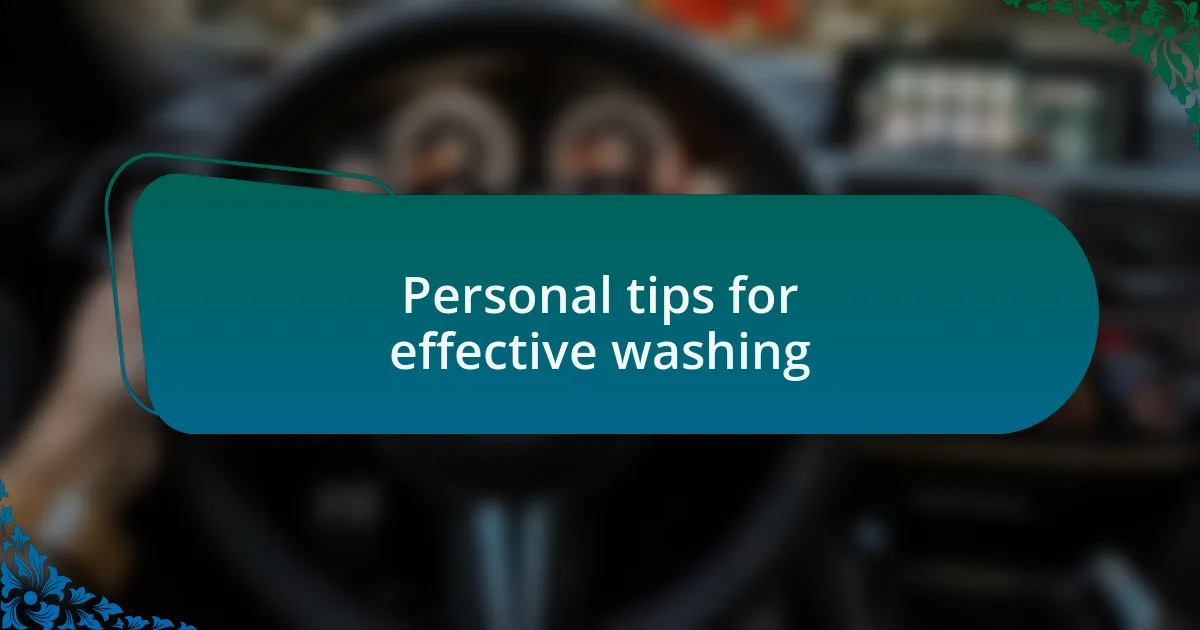Key takeaways:
- Hand washing promotes mindfulness and allows for personal connection with the vehicle while identifying potential issues.
- Using the right tools, such as microfiber cloths and detailing brushes, enhances the efficiency and effectiveness of the cleaning process.
- Common mistakes include using the wrong type of cleaning equipment and neglecting rinsing, which can lead to visible streaks or scratches.
- Adopting a systematic approach, like washing from top to bottom and using two buckets, improves the overall results of hand washing.

Car wash overview
When I think about car washes, I often reflect on how they can transform not just the appearance of a vehicle, but also the mood of the driver. There’s something satisfying about watching grime and dirt dissolve away, leaving behind that gleaming finish. Have you ever found yourself smiling as you see your car’s original color reemerge?
There are various types of car washes available today, from automatic systems that do the job in minutes to hand washes that require a bit more time and care. Personally, I prefer the latter; there’s a certain mindfulness in hand washing that makes me feel connected to my car. I often use it as a meditative break in my busy schedule, where I can focus on the task and clear my mind.
Car washes aren’t just about aesthetics; they also play a crucial role in maintaining your vehicle’s longevity. Regular cleaning helps prevent rust and corrosion, especially if you live in areas prone to harsh weather conditions. Have you experienced how a clean car seems to drive better? There’s definitely a correlation between how well you care for your vehicle and its performance.

Importance of hand washing
Hand washing your car is more than just a chore; it’s a vital practice that reinforces good habits in vehicle care. I’ve always believed that taking the time to wash my car by hand helps me appreciate its details — from the shiny chrome accents to the unique shape of its body. Isn’t it satisfying to know that every inch is getting personal attention?
Moreover, hand washing allows me to notice issues that I might miss when using an automated wash. Just last month, I found a small scratch on the side that needed touch-up paint. If I hadn’t been washing my car by hand, I might not have caught it in time, leading to more significant problems down the road. It’s almost like a bonding experience with my vehicle; I can truly see and feel its state, and that connection encourages me to drive more responsibly.
On a broader scale, hand washing promotes environmental awareness because it reduces water wastage and avoids harmful chemicals that are often used in automated washes. In fact, I’ve switched to eco-friendly cleaning products that are safe for both my car and the planet. How great does it feel to know you’re doing your part for the environment while keeping your vehicle in top shape? This mindful approach to car maintenance feels like a win-win to me.

Common mistakes in hand washing
When it comes to hand washing, one of the most common mistakes I’ve made is using the wrong type of sponge or cloth. I remember when I first started, I used a rough sponge that left tiny scratches on my car’s surface. It’s easy to think a tougher sponge will do a better job, but it can actually damage your paint. So, always opt for a microfiber cloth; it’s gentle yet effective, and your car will thank you.
Another mistake I’ve encountered is washing in direct sunlight. The first time I washed my car on a bright, sunny day, I noticed that the soap dried too quickly, leaving streaks behind. This taught me a valuable lesson about timing; it’s essential to wash your car in the early morning or late afternoon. Have you ever had the frustrating experience of seeing water spots after you’ve put in so much effort? Avoiding these situations can make a significant difference in the final look.
Lastly, I realized that neglecting the rinse process is a big error many make, including myself. I used to think that a quick rinse would suffice, but I learned the hard way that soap residue can harm the finish over time. The extra few minutes you spend rinsing thoroughly will save you from potential long-term consequences. Have you ever felt the frustration of seeing your hard work diminish because of a small oversight? Taking the time to do it right pays off in the end.

Essential tools for hand washing
Having the right tools can transform your hand-washing experience significantly. I once thought I could get away with using any old bucket, but after spilling soapy water everywhere, I learned the value of a sturdy, non-slip one. A quality bucket with measurement markings not only keeps everything organized but also ensures you mix the perfect soap-to-water ratio, maintaining that smooth application I crave.
Another essential tool is a detailing brush. Initially, I underestimated its power, thinking I could just scrub everything with a cloth. However, I discovered that a brush can reach those stubborn spots and tight crevices that a cloth can miss. Don’t you hate when dirt lingers in places you can’t easily access? I remember feeling that frustration until I invested in a set of soft-bristled brushes specifically designed for auto detailing.
Finally, let me share the importance of a good wash mitt. I used to rely on just a cloth, but I quickly realized that a mitt provides better control and allows for a more thorough clean. The first time I used one, I felt the difference immediately – it glided over the surface effortlessly, making the task almost enjoyable. Why settle for anything less than the best when it comes to caring for your vehicle?

Personal tips for effective washing
One critical tip I’ve learned over time is to always wash your vehicle from the top down. I remember a time when I started washing my car from the bottom and ended up splashing dirty water back onto the freshly cleaned surfaces. It was a frustrating cycle that could have been avoided! Now, I always begin at the roof and work my way down, ensuring dirt and grime gently drip away, rather than creating a mess.
Another effective strategy is to tackle one section at a time. I found that breaking the car washing process into manageable chunks not only keeps me focused, but it also helps me pretend I’m a detailer on a mission. By concentrating on, say, one door or the front bumper, I can give each area the attention it deserves and observe how satisfying it is to watch the dirt disappear.
Lastly, I’ve discovered the advantages of using two buckets—one for soapy water and one for rinsing. At first, I thought using just one bucket would suffice, but it turned out that rinsing my wash mitt regularly helped me avoid scratching the paint with trapped grit. It’s like a simple dance now: dip into the soapy bucket, wash, then rinse in the other. Incorporating this method into my routine feels incredibly professional and makes a noticeable difference in the final result. Isn’t it remarkable how a few small changes can elevate your hand washing game?